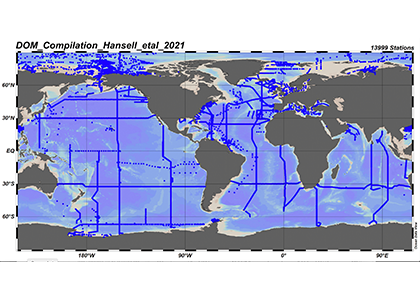This compilation consists of measurements of dissolved organic matter (DOM) and other chemical and hydrographic parameters obtained during the global ocean observations from 1994-01-01 to 2019-12-31. Measurements of dissolved organic matter (DOM) in the open ocean have increased greatly since the late 1980’s, spurred by the growth in scientific interest directed at the ocean carbon cycle. DOM data generated by many laboratories around the world are typically made available in diverse, regional data archives, making them less available than necessary for the data value to be maximized. The effort here was to make ship-collected bottle data accessible more directly and in uniform format. The emphasis was on spatial coverage of the global ocean, so the well-known and ongoing time-series data (such as the Bermuda Atlantic Time-series Study and Hawaiian Ocean Time-series) are not included; nor are coastal waters well represented in this first version. While the focus of this compilation is largely on dissolved organic carbon (DOC) and total dissolved nitrogen (TDN), we extended coverage to include the less frequently determined DOM isotopes (13C, 14C), select wavelengths and a single spectral slope of colored dissolved organic matter (CDOM), and DOM composition (i.e., dissolved combined neutral sugars). To the extent possible, the DOM data have been complemented with hydrographic data (e.g., temperature and salinity), other biogeochemical variables (e.g., oxygen, nutrients), the inorganic carbon system [e.g., dissolved inorganic carbon (with isotopes when available), pH, and total alkalinity], and anthropogenic (chlorofluorocarbons, sulfur hexafluoride, carbon tetrachloride) and natural tracers (neon, helium, tritium). A very few data are included for biological variables such as bacterial abundance and chlorophyll a concentrations. These data, from approximately 14000 stations (map below), are from taken from 230 cruises, providing 94324 measures of DOC (full water column where available) and 29113 measures of TDN (limited to the surface 250 m).
Data access:
NCEI data and metadata: https://www.ncei.noaa.gov/access/ocean-carbon-data-system/oceans/ndp_109/ndp109.html
ODV collection: https://odv.awi.de/data/ocean/dom-compilation-hansell-et-al-2021/
ODV online analysis: https://explore.webodv.awi.de/ocean/biogeochemistry/dom/hansell-etal-2021/
CITE AS: Hansell, Dennis A.; Carlson, Craig A.; Amon, Rainer M. W.; Álvarez-Salgado, X. Antón; Yamashita, Youhei; Romera-Castillo, Cristina; Bif, Mariana B. (2021). Compilation of dissolved organic matter (DOM) data obtained from the global ocean surveys from 1994 to 2020 (NCEI Accession 0227166). [indicate subset used]. NOAA National Centers for Environmental Information. Dataset. doi.org/10.25921/s4f4-ye35. Accessed [date].





